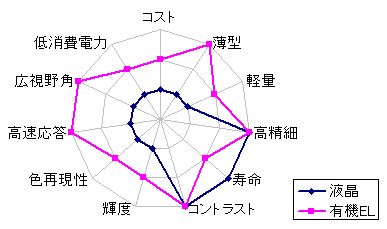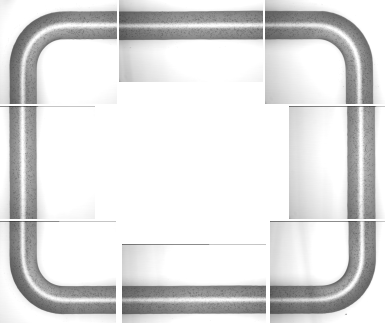What is an organic EL display?
Liquid crystal displays (LCDs) are the most commonly used devices today, and they are used in personal computers, mobile phones, and recently televisions. Although this liquid crystal display is characterized by low power consumption, it has to be illuminated from the back side (backlight) because it does not emit light by itself, which is an obstacle to miniaturization and weight reduction.
An organic EL display is a display that emits light by itself, like a plasma display (PDP). It has a structure in which an extremely thin organic material film is sandwiched between thin electrodes. In addition, since it emits light by itself, it does not require a backlight, and it is the most anticipated display today because of its high image quality and high-speed rendering.

Fig. 1 Performance comparison between liquid crystal display and organic EL display
Transition to screen-printing method
In the conventional organic EL manufacturing process, a device called a dispenser was used to apply an adhesive to overlap two thin substrates.
This device, called a dispenser, applies the adhesive in a single stroke, and if you try to manufacture many panels at one time from a single piece of glass, the total application distance will be long, and it will take a very long time.
Therefore, it is considered to apply this adhesive by the screen printing method.
This device, called a dispenser, applies the adhesive in a single stroke, and if you try to manufacture many panels at one time from a single piece of glass, the total application distance will be long, and it will take a very long time.
Therefore, it is considered to apply this adhesive by the screen printing method.
With screen printing, printing can be done in about 1/3 of the coating time of a dispenser, and the printing time per 1 workpiece does not change whether 10 or 20 sheets are taken.
Our dedicated vacuum screen printer (based on LS-340VTVA) combines the printing technology we have cultivated over many years in the manufacturing of liquid crystal panel and PDP production equipment with a high viscosity, high thixotropic UV curable epoxy resin seal for dispensers. While using the material as it is, more precise application than a dispenser is possible.
Naturally, air bubbles do not get mixed in, and in addition, since nitrogen gas is purged when opening to the atmosphere after printing or when workpieces are loaded or unloaded, moisture does not affect the sealing material.
In addition to applying adhesives, this printer can also be used to apply liquid desiccants and thin film encapsulation.
In addition to applying adhesives, this printer can also be used to apply liquid desiccants and thin film encapsulation.

Featured in specialized magazines
This information was also published in the April 15, 2004/May 1 joint issue of E-Express, a magazine specializing in flat display panels.
e-express websiteClick here...>>>
articleIf you would like to know more about it,please use this form.Please contact us.
